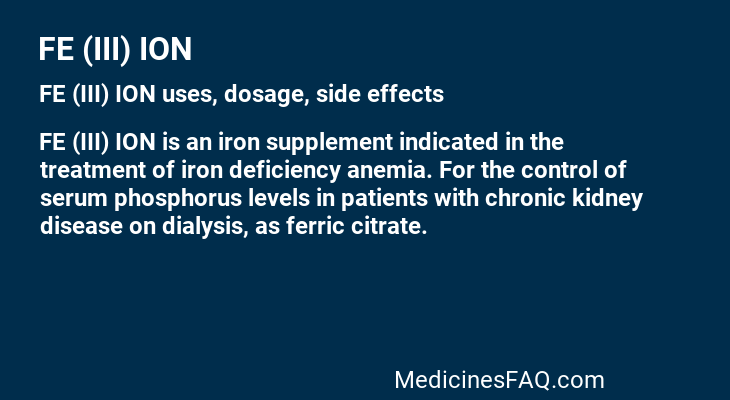FE (III) ION
FE (III) ION Uses, Dosage, Side Effects, Food Interaction and all others data.
Iron is a transition metal with a symbol Fe and atomic number 26. By mass, it is the most common element on Earth. Iron is an essential element involved in various metabolic processes, including oxygen transport, deoxyribonucleic acid (DNA) synthesis, and energy production in electron transport . Resulting from inadequate supply of iron to cells due to depletion of stores, iron deficiency is the most common nutritional deficiency worldwide, particularly affecting children, women of childbearing age, and pregnant women . Iron deficiency may be characterized without the development of anemia, and may result in functional impairments affecting cognitive development and immunity mechanisms, as well as infant or maternal mortality if it occurs during pregnancy . The main therapeutic preparation of iron is Ferrous sulfate, and iron-sucrose may also be given intravenously .
Iron exists in two oxidation states: the ferrous cation (Fe2+) and ferric cation (Fe3+). Non-haem iron in food is mainly in the ferric state, which is the insoluble form of iron, and must be reduced to the ferrous cation for absorption . Ferric citrate (tetraferric tricitrate decahydrate) is a phosphate binder indicated for the control of serum phosphorus levels in patients with chronic kidney disease on dialysis.
When Fe3+ is converted to soluble Fe2+, it primarily exists in the circulation in the complex forms bound to protein (hemoprotein) as heme compounds (hemoglobin or myoglobin), heme enzymes, or nonheme compounds (flavin-iron enzymes, transferring, and ferritin) . Once converted, Fe2+ serves to support various biological functions. Iron promotes the synthesis of oxygen transport proteins such as myoglobin and hemoglobin, and the formation of heme enzymes and other iron-containing enzymes involved in electron transfer and redox reactions . It also acts as a cofactor in many non-heme enzymes including hydroxylases and ribonucleotide reductase . Iron-containing proteins are responsible in mediating antioxidant actions, energy metabolism, oxygen sensing actions, and DNA replication and repair . Saturation of transferrin from high concentrations of unstable iron preparations may elevate the levels of weakly transferrin-bound Fe3+, which may induce oxidative stress by catalyzing lipid peroxidation and reactive oxygen species formation .
| Trade Name | FE (III) ION |
| Generic | Ferric cation |
| Ferric cation Other Names | FE (III) ION, Fe(III), Ferric ion, iron(3+) |
| Type | |
| Formula | Fe |
| Weight | Average: 55.845 Monoisotopic: 55.934942133 |
| Protein binding | Fe3+ is converted to Fe2+, which is bound and transported in the body via circulating transferrin. In pathogenic Neisseria, ferric iron-binding protein serves as the main periplasmic-protein for ferric iron that has equivalence to human transferrin . Once in the cytosol, ferric iron is stored in ferritin where it is associated with hydroxide and phosphate anions . |
| Groups | Approved |
| Therapeutic Class | |
| Manufacturer | |
| Available Country | |
| Last Updated: | September 19, 2023 at 7:00 am |

Uses
FE (III) ION is an iron supplement indicated in the treatment of iron deficiency anemia.
For the control of serum phosphorus levels in patients with chronic kidney disease on dialysis, as ferric citrate.
FE (III) ION is also used to associated treatment for these conditions: Hyperphosphataemia, Iron Deficiency Anemia (IDA)
How FE (III) ION works
Iron is incorporated into various proteins to serve biological functions as a structural component or cofactor. Once ferric or ferrous cation from intestinal enterocytes or reticuloendothelial macrophages is bound to circulating transferrin, iron-transferrin complex binds to the cell-surface transferrin receptor (TfR) 1, resulting in endocytosis and uptake of the metal cargo. Internalized iron is transported to mitochondria for the synthesis of heme or iron-sulfur clusters, which are integral parts of several metalloproteins . Excess iron is stored and detoxified in cytosolic ferritin . Internalized Fe2+ exported across the basolateral membrane into the bloodstream via Fe+2 transporter ferroportin, which is coupled by reoxidation to Fe3+ via membrane-bound ferroxidase hephaestin or ceruloplasmin activity . Fe+3 is again scavenged by transferrin which maintains the ferric iron in a redox-inert state and delivers it into tissues .
Fe3+ participates in the autoxidation reaction, where it can be chelated by DNA. It mainly binds to the backbone phosphate group, whereas at higher metal ion content, the cation binds to both guanine N-7 atom and the backbone phosphate group .
Toxicity
The LD50 of ferric compounds vary. High concentrations of ferric iron from unstable and oversaturation of ferritin may lead to adverse events such as hypotension, nausea, vomiting, abdominal and lower back pain, peripheral edema and a metallic taste .
Food Interaction
- Avoid milk and dairy products.
- Take with food. Take ferric cation with or just after meals.
Volume of Distribution
Less than 65% of iron is stored in the liver, spleen, and bone marrow, mainly as ferritin and haemosiderin . The pharmacokinetic properties of ferric compounds vary.
Elimination Route
Iron absorption and systemic iron homeostasis are regulated by hepcidin, which is a peptide hormone that also regulates the activity of the iron-efflux protein, ferroportin-1 . Iron is mostly absorbed in the duodenum and upper jejunum . Fe3+ displays low solubility at the neutral pH of the intestine and is mainly be converted to ferrous iron (Fe2+) by ferric reductases , as ferric salts are only half as well absorbed as ferrous salts . Once converted in the intestinal lumen, Fe+2 is transported across the apical membrane of enterocytes . The absorption rate of non-haem iron is 2-20% . Stored iron may be liberated via ferroportin-mediated efflux, which is coupled by reoxidation of Fe2+ to Fe3+ by ceruloplasmin in the serum or hephaestin in the enterocyte membrane . Fe3+ subsequently binds to transferrin, which keeps ferric cation in a redox-inert state and delivers it into tissues .
It is proposed that there may be separate cellular uptake pathways for ferrous iron and ferric iron. While ferrous iron is primarily carried by divalent metal transporter-1 (DMAT-1), cellular uptake of ferric iron is predominantly mediated by beta-3 integrin and mobilferrin, which is also referred to as calreticulin in some sources as a homologue . However, the most dominant pathway in humans is unclear .
Half Life
The pharmacokinetic properties of ferric compounds vary.
Clearance
The rate of iron loss is approximately 1 mg/day . The pharmacokinetic properties of ferric compounds vary.
Elimination Route
Iron is predominantly conserved in the body with no physiologic mechanism for excretion of excess iron from the body, other than blood loss . The pharmacokinetic properties of ferric compounds vary.
Innovators Monograph
You find simplified version here FE (III) ION







